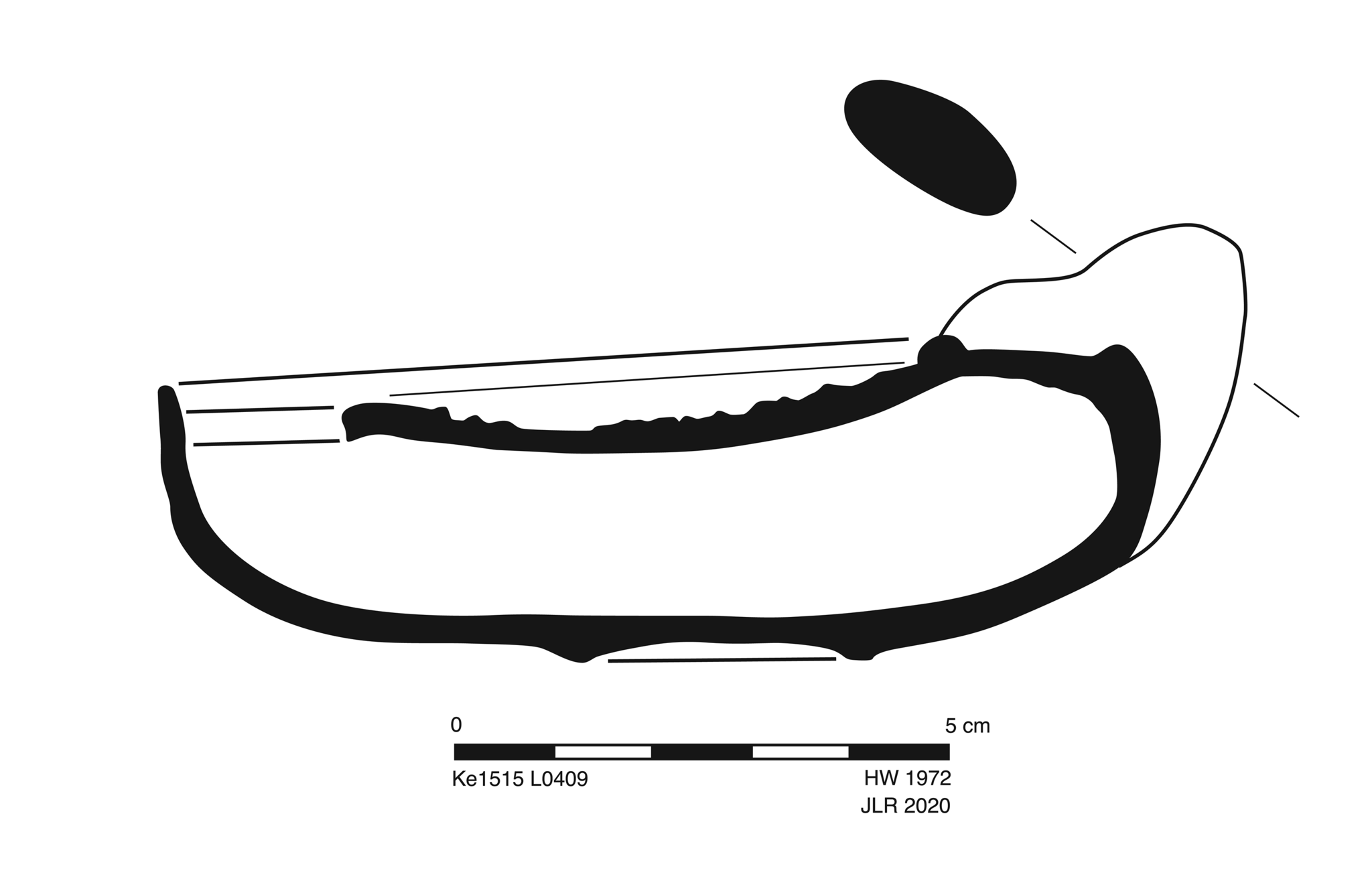- KE 1515 (Late Roman North African Lamp) [permalink] [next]
- Type
- Inventoried Object
- Logical part of
- Chicago/Indiana/Vanderbilt Excavations Inventoried Objects
- Subject number
- L 409
- Typological identification
- African Red-Slip Lamp Hayes Type II
- Typological identification comment
- Retouched copy: Athenian?
- Comparanda
- cf. Museo Sacro Vaticano 1308
- Comparanda
- cf. BernaboBrea1947, pp. 56, 59, fig. 2, pl. (Museo di Siracusa; from area)
- Comparanda
- cf. Bussiere2007, pp. 105-106, nos. C 355, C 356, pl. 23 (Musée de Timgad; from area)
- Comparanda
- cf. Delattre1892, pp. 95, 135, no. 682=DACL, VIII.1 (1927), s.v. Lampes, coll. 1171-1172, no. 1085, fig. 6681:4 (H. Leclerq)=Ennabli1976, p. 52, no. 75, pl. III (Bardo; from Carthage)
- Comparanda
- cf. Delattre1899, pp. 39-40, pl. IX:5 (Musée Lavigerie de St.-Louis, Carthage; from area)
- Comparanda
- cf. Gentili19531955], pp. 85-88, figs. 1, 4, pl. II (Piazza Armerina, Sicily)
- Comparanda
- cf. GerousiBendermacher2013, p. 142, no. 198 (Perissa, Thera)
- Comparanda
- cf. LyonCaenHoff1986, pp. 102-103, no. 50 (Louvre; from North Africa?)
- Description
- Elongated tear-shaped in keyhole format. Mostly circular, flat discus has design in low relief, two filling holes center left and right, and sharply raised rim. Design depicts scene of Ascension: 1) central discus: Jesus Christ standing frontal in densely folded long tunic, bearded face and halo around head, right hand raised holding holding uncertain conical object and left hand flexed at side holding staff diagonal across torso with cross at top; 2) middle to top of discus: rounded, raised field (mandorla?) behind and around body, above which is tetramorph (left to right: eagle’s head facing left, angelic head facing right, bull’s head facing left and two small rearing legs, and small lion striding left); 3) middle to lower discus: two cherubim crouching opposite at feet of Christ, wings raised and legs stretched out in front; 4) bottom of discus and into channel: two men(?) in short tunics standing frontal or turned slightly left, facing inward(?), right arm raised (saluting?) and left arm at side. Shoulder with rounded rim has broad groove with row of eight motifs in relief on each side (see Bussière and Rivel 2015). Left, top to bottom: 1) dotted cross with flaring arms in double circle? (Dm5); 2) 4 x 5 checkboard in square (modified Ad1); 3) fleuron with four petals (distorted Fa11) ; 4) 4 x 4/5 checkboard in square (distorted Ad1); 5) fleuron with four petals (distorted Fa9); 6) narrow fleuron with four petals? (Fc2); 7) fleuron with six petals (Fg7); 8) small volute(?) palmette (cf. La5-9). Right, to to bottom: 1) dotted quatrefoil in circle? (Dm5); 2) 3 x 3 pellets in square (modified Aa26); 3) reverse Constantinian monogram in circle (distorted Dj); 4) double circle in double square? (Aa20); 5) fleuron with six petals (Fg7); 6) 2) 3 x 3 pellets in square? (modified Aa26); 7) quatrefoil, encircled? (distorted Fa10); 8) small volute(?) palmette (cf. La5-9). Circular raised base with rim and ridge to handle. The overall schematic rendering of figural and ornamental details, and the wide variety of motifs with occasional stray ridges or impressions around them (copying? slipping poinçons? retouching?), suggests that this is a late generation copy from a unique original design (see comparanda).
- Published as
- KenchreaiV, p. 82, no. 426, pls. 19, 24 (H. Williams)
- Base Diameter
- 0.032
- Discus length
- 0.04
- Discus width
- 0.0365
- Handle total height
- 0.044
- Height base to shoulder
- 0.032
- Height shoulder to handle
- 0.012
- Length
- 0.109
- Width
- 0.059
- Material
- Ceramic (Material)
- Has visual motif (depicts)
- Bull or Cow (Visual Motif)
- Has visual motif (depicts)
- Christian Cross (Visual Motif)
- Has visual motif (depicts)
- Eagle (Visual Motif)
- Has visual motif (depicts)
- Jesus Christ (Visual Motif)
- Has visual motif (depicts)
- Lion (Visual Motif)
- Drawing
-

- Drawing
-

- Pagescan
- Photograph
-

- Photograph
-




